Einkorn flour brings a lovely old-world charm to the kitchen, doesn’t it? If you’re experimenting with Einkorn for the first time or you’ve been a long-time fan, this Einkorn bread recipe is a real treat. Simple enough for any baker, this loaf can be made using a bread machine or the traditional oven method. The result is a delightful bread that’s just right for your favorite sandwiches, a crunchy toast, or even by itself with a dab of butter. Let’s get baking!
Baking with Einkorn wheat flour is becoming more popular as people learn about the benefits of this ancient grain. Einkorn flour bread has a nutty flavor and a slightly denser texture than bread made with modern wheat.
Despite its numerous benefits, switching to Einkorn involves a learning curve. For the past few years, I have perfected my family’s favorite recipes to Einkorn flour. I share my best tips and recipes with you so you don’t need to waste time and money on trial and error.
This recipe comes in two variations: one for the bread machine and another for oven baking. You can use our handy Einkorn Conversion chart to substitute whole wheat Einkorn flour instead of all-purpose in your recipes! Now for the Einkorn bread recipe.

Einkorn Bread Recipe
Ingredients
- 4 cups Einkorn flour
- 1 1/2 cups warm water – 110-115 degrees F
- 1 packet of active dry yeast
- 1 tsp real salt
- 2 Tbsp unsalted butter, cut into small cubes and softened
- 1/4 tsp ground ginger powder
- 1/2 tsp apple cider vinegar
Notes
- If you prefer to proof your yeast, place it in a bowl with the warm water and let it sit while you mix the other ingredients. Crucially, do not add salt to the warm water with the yeast; instead, mix the salt into the flour first. Once the yeast has proofed, pour the yeast-water mixture into the flour mixture. Then, continue with the rest of the recipe as usual.
- Einkorn is heavier than other flours, but both ginger and ACV help with the rise. Don’t worry, you won’t taste them at all.
- Einkorn dough is stickier than all-purpose flour dough. It’s not wetter per se, just stickier. For more helpful information, see our tips for using Einkorn flour.
- I use raw, organic ACV that has 6.3% acidity. If you use a 5% acidity ACV, you may have to increase the amount to 3/4 tsp to get the desired rise.
- Find more Einkorn bread-making tips.
- Read about why we use real salt.




Instructions for Oven Baking
- Put flour, ginger, and yeast in a bowl and combine well. (See Notes Above for an Alternative Method to Proof the yeast first if you prefer doing that.)
- Add the butter cubes and combine them until they’re smaller chunks. Don’t worry about them being chunky.
- Heat the water to 110-115 degrees F – do not heat the water above 115 or you will kill the yeast. If you overheat it, let it cool to the right temperature before adding it to the flour mixture.
- Add the ACV and salt to the warm water.
- If you have an electric mixer with a bread hook, use it. If not, you can knead the dough by hand.
- Turn the mixer to low and slowly add the warm water mixture to the flour while mixing on low for 10 minutes.
- After 10 minutes of mixing, turn off the mixer and scrape down the sides of the bowl.
- Next, place the dough in a greased bowl and turn to coat all sides. Cover with plastic wrap or a damp towel. I have been using these plastic proofing bags for about a year now and love them. I get a better rise using them.
- Allow the bread to rise in a warm area for 25 minutes or until it is 60% its original size.
- Remember, Einkorn bread should not double in size. Overproofing Einkorn dough will cause it to collapse when baked, so be careful not to overprove.
- Butter or oil a bread pan.
- Shape the dough in the form of your bread pan, then place it seam-side down into the pan.
- I prefer to work bread with hands moistened with water, but you can oil or butter your hands instead.
- Cover the pan with plastic wrap, a moist towel, or the proofing bag I use, and let the bread rise for another 25 minutes or until it is 60% risen. If it rises to touch the cover, remove it and let it continue to rise uncovered.
- Bake in a preheated 375-degree F oven for 45-50 minutes or until golden brown.
- Place the pan on its side on a cooling rack and allow it to sit for 10 minutes before removing the loaf from the pan.
- Turn the bread out on the cooling rack and let it sit until completely cool before slicing. This will take about an hour.
- I must confess, I often slice the end off and try it with some butter before it’s cool.
- Slicing your bread before it’s completely cool will cause it to have a more crumbly texture. I’m told this is due to moisture escaping from the loaf in the steam.
Instructions for Bread Machine
- Add water and ACV to the bread machine pan.
- Then add, in this order:
- The flour.
- Make a well in the middle of it and add the yeast.
- Next, add the salt to one end.
- Lastly, divide the butter cubes between the corners of the pan.
- Every bread machine is different, so adjust these directions for your machine.
- Set a 10-minute mixing/kneading cycle.
- I have to set my machine on the whole wheat bread setting and then set a timer to remind me to stop it after the mixing cycle. I do this because this setting has a 10-minute kneading(mixing) cycle.
- Once the mixing cycle is complete, set a 50-minute rising (or fermenting, as my machine calls it) cycle.
- When the time has passed, set a 50-minute bake cycle. Set the crust to the desired brownness. I use the medium setting.
- Set a 10-minute mixing/kneading cycle.
- If your machine has a customizable cycle, that is awesome. Set the above parameters and start the machine.
- Once the bread is finished baking, remove the pan from the machine. Set it on its side on a cooling rack and allow it to cool for 10 minutes before removing the loaf.
- After 10 minutes, turn the loaf out of the pan onto the cooling rack and allow it to cool completely before slicing.
- Letting it cool completely will help prevent a crumbly loaf.

How to Store Homemade Bread
- Homemade bread can be stored in an airtight container at room temperature for 3-5 days.
- I use these bread bags and put it in the fridge. I just started using these this year and I love them.
- It will keep for about 2 weeks if kept in the fridge.
- It can be frozen for 6 months. Slice it first and wrap individual slices in parchment or freezer paper before placing them in a freezer bag. The longer it’s stored, the less fresh it will be.
I store my bread in slices and/or in the freezer.
- For more extended storage, I freeze them and thaw them out the night before I need them.
- After the bread is completely cooled, I slice it into thin slices.
- I wrap the pieces that don’t cut well enough for sandwiches in parchment paper and put them in a food storage bag or box for toast.
- I write “toast” or “sandwich” on the outside of the bag or on a piece of freezer tape on the container.
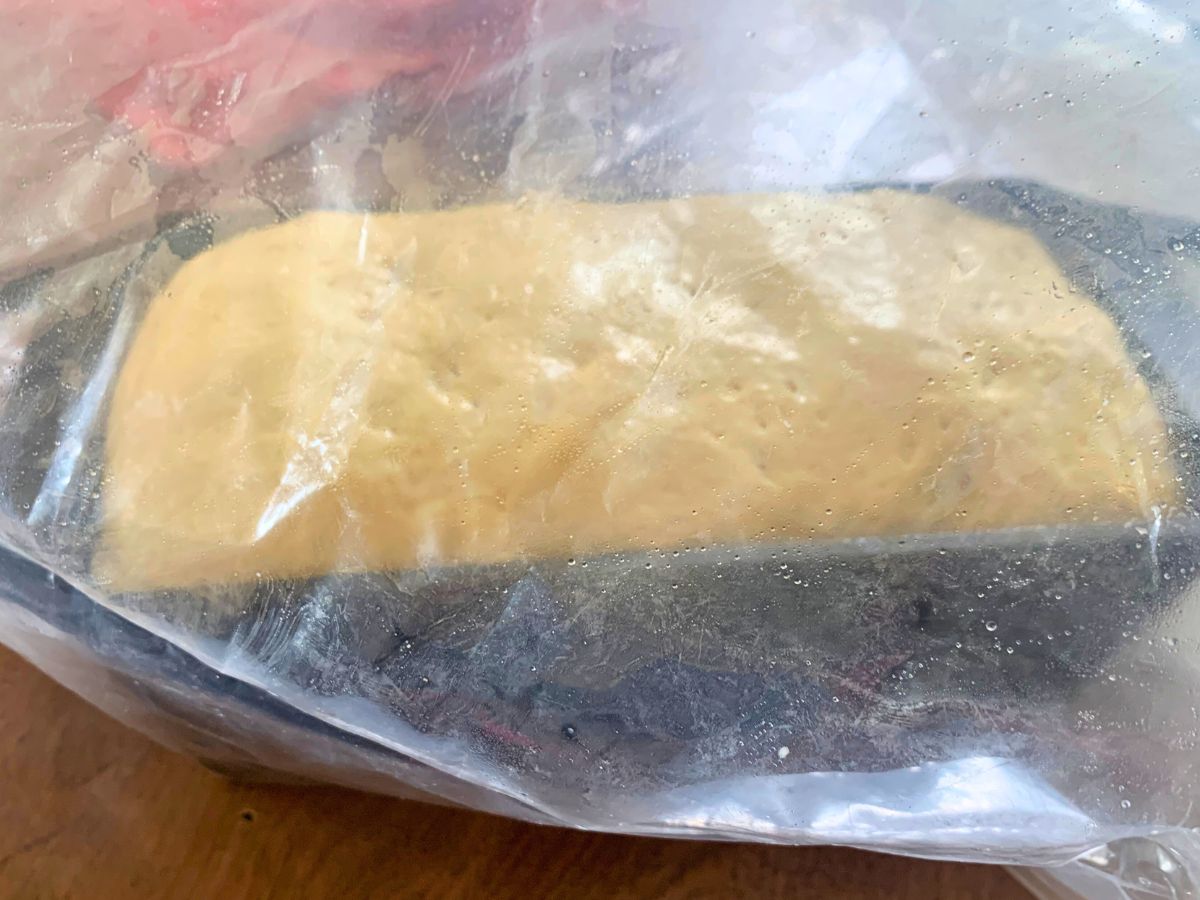
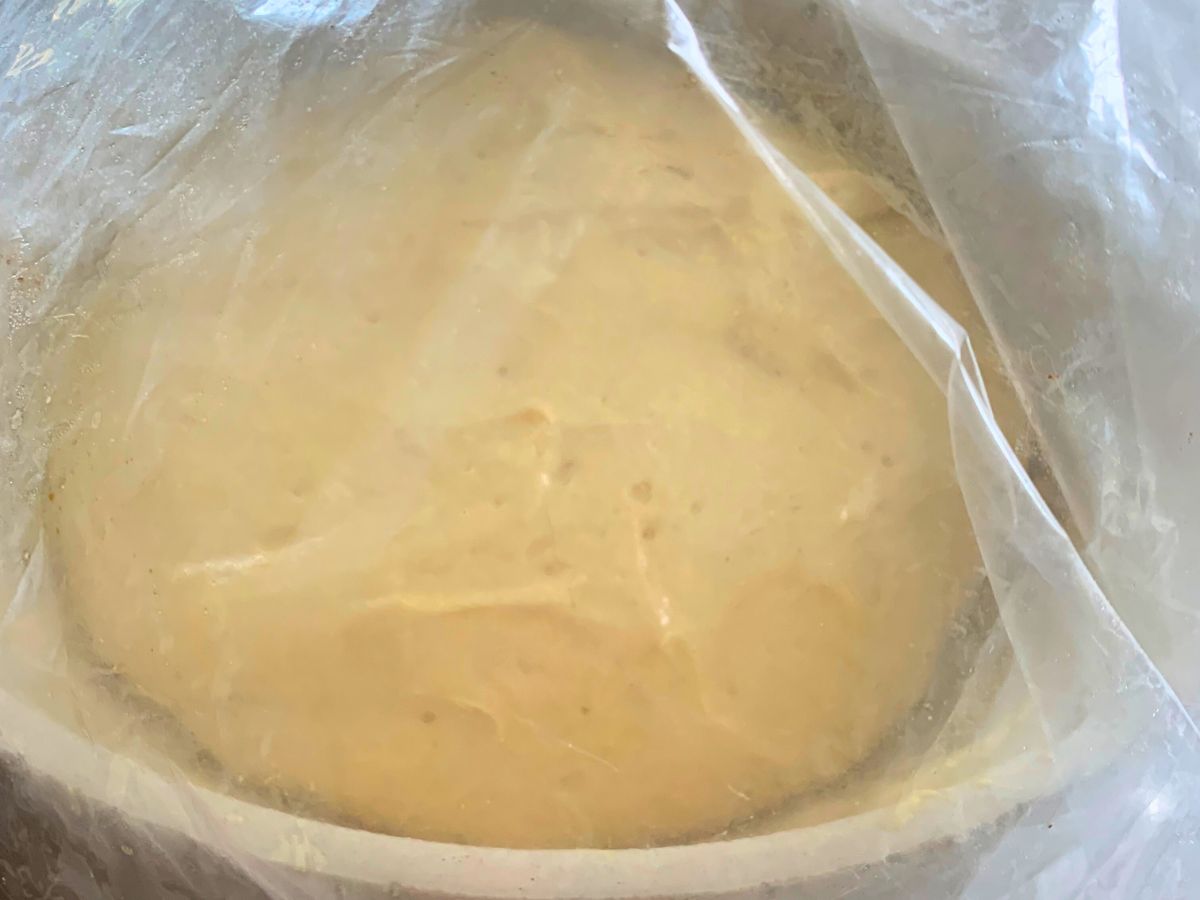
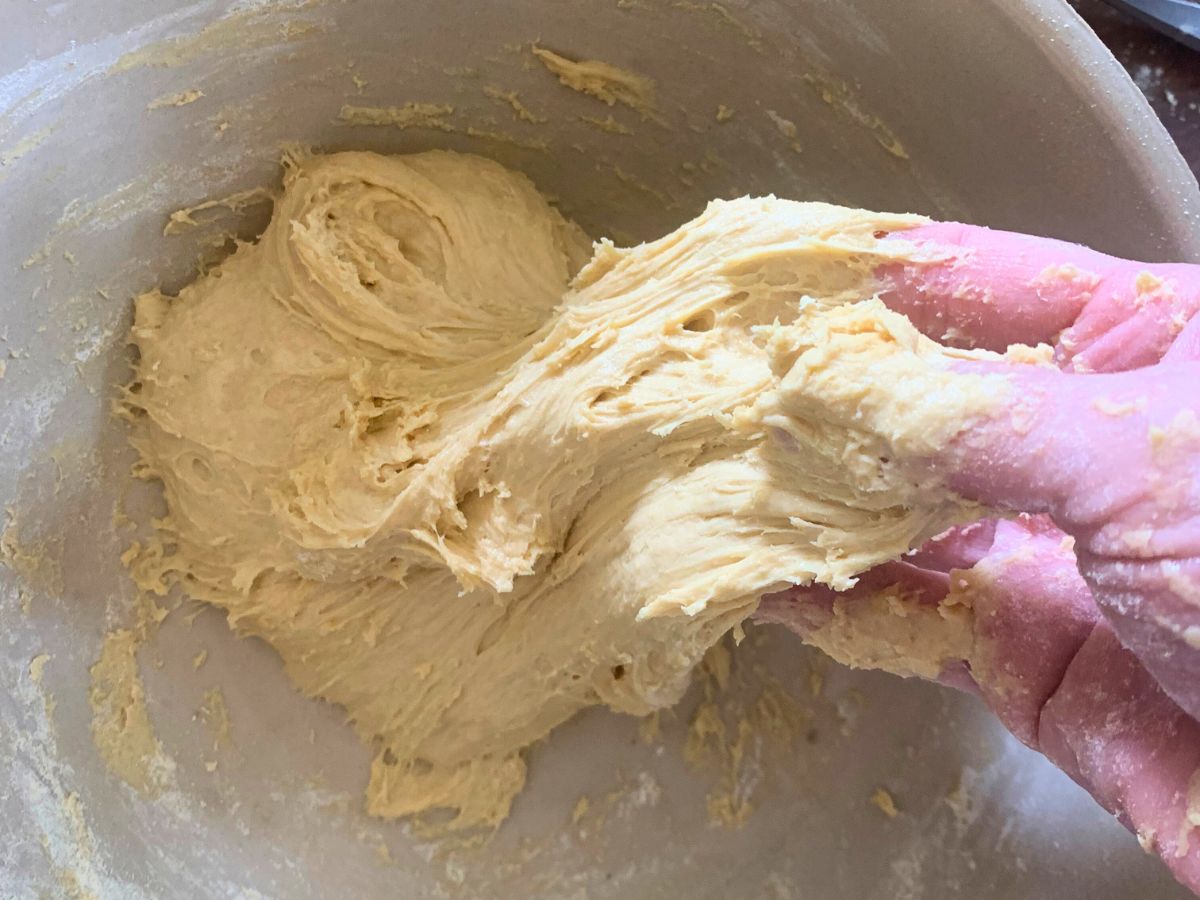
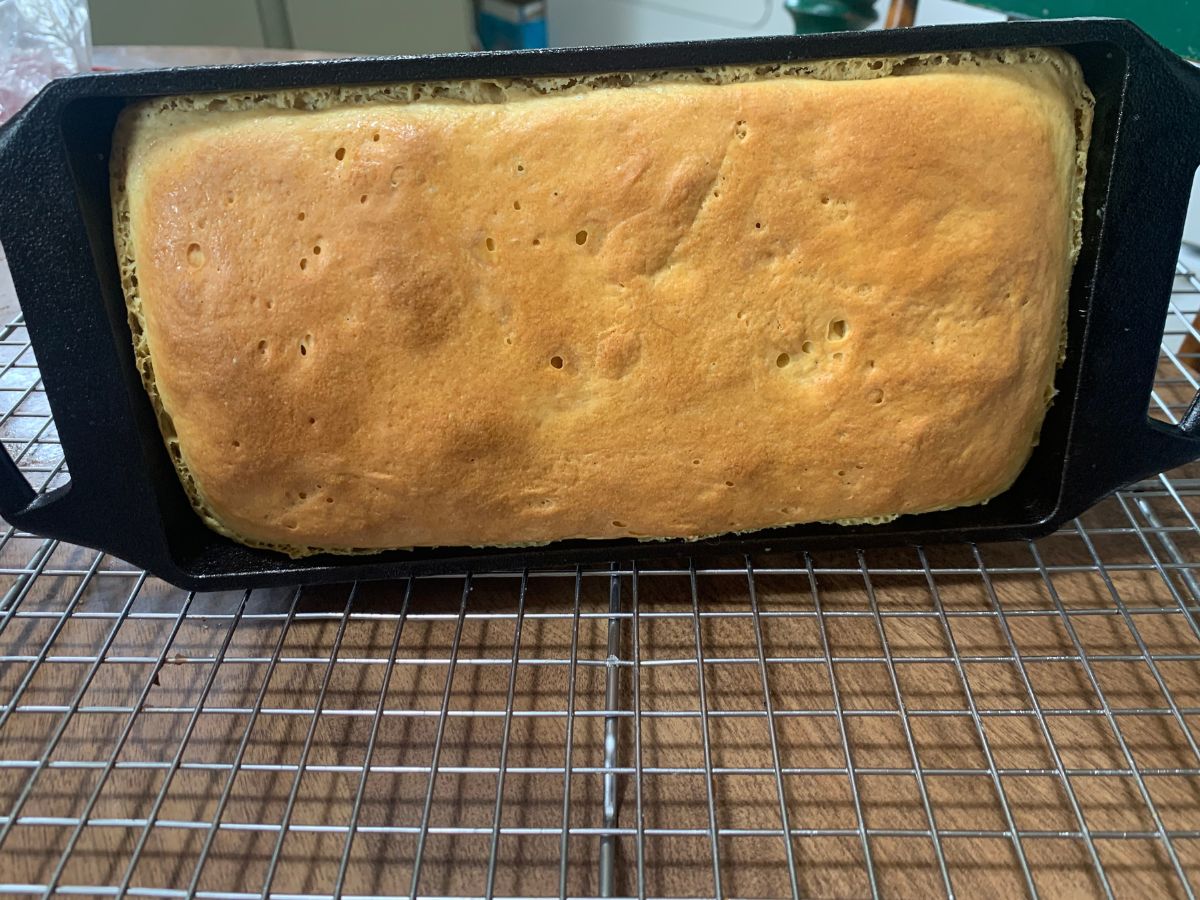

Einkorn Bread Recipe
Ingredients
- 4 cups All-purpose Einkorn Flour
- 1 ½ cups warm water – 110-115 degrees F
- 1 packet active dry yeast
- 1 tsp real salt
- 2 Tbs unsalted butter, cut into cubes and softened
- ¼ tsp ground ginger powder
- ½ tsp apple cider vinegar See notes
Instructions
Instructions for Oven Baking
- Put flour, ginger, yeast in a bowl and combine well. (See the notes below for an alternative method of proofing the yeast first, if you prefer doing that)
- Add the butter cubes and combine them until they're smaller chunks. Don't worry about them being chunky.
- Heat the water to 110-115 degrees F – do not heat the water above 115 or you will kill the yeast. If you overheat it, let it cool to the right temperature before adding it to the flour mixture.
- Add the ACV and salt to the warm water.
- If you have an electric mixer with a bread hook, use that. If you don’t have a mixer, you can knead the dough by hand.Turn the mixer to low and slowly add the warm water mixture to the flour while mixing on low for 10 minutes.
- After 10 minutes of mixing, turn off the mixer and scrape down the sides of the bowl.
- Next, place the dough in a greased bowl and turn to coat all sides. Cover with plastic wrap or a damp towel.I have been using these plastic proofing bags for about a year now and love them. I get a better rise using them.
- Allow bread to rise in a warm area for 25 minutes or until it is 60% its original size.Remember, Einkorn bread should not double in size. Overproofing Einkorn dough will cause it to collapse when baked, so be careful not to overprove.
- Butter or oil a bread pan.
- Shape the dough to the form of your bread pan then place it seam-side down into the pan.I prefer to work bread with hands moistened with water, but you can oil or butter your hands instead.
- Cover the pan with plastic wrap, a moist towel, or the proofing bag I use, and let the bread rise for another 25 minutes or until it is 60% risen. If it rises to touch the cover, remove it and let it continue to rise uncovered.
- Bake in a preheated 375-degree F oven for 45-50 minutes or until golden brown.
- Place the pan on its side on a cooling rack and allow it to sit for 10 minutes before removing the loaf from the pan.
- Turn the bread out on the cooling rack and let it sit until completely cool before slicing. This will take about an hour.Slicing your bread before it’s completely cool will cause it to have a more crumbly texture. I’m told this is due to moisture escaping from the loaf in the steam.
Instructions For Bread Machine
- Add water and ACV to the bread machine pan.
- Then add to the pan, in this order:The flour. Make a well in the middle of it and add the yeast.Next, add the salt to one end.Lastly, divide the butter cubes between the corners of the pan.
- Every bread machine is different so adjust these directions to your machine.(1) Set a 10-minute mixing/kneading cycle. I have to set my machine on the whole wheat bread setting and then set a timer to remind me to stop it after the mixing cycle. I do this because this setting has a 10-minute kneading(mixing) cycle.(2) Once the mixing cycle is complete, set a 50-minute rising (or fermenting as it’s called on my machine) cycle.(3) When the time has passed, set a 50-minute bake cycle. Set the crust to the brownness you want, I use the medium setting.
- If you have a customizable cycle that is awesome. Set the above parameters and start the machine.
- Once the bread is finished baking, remove the pan from the machine. Set it on its side on a cooling rack and allow it to cool for 10 minutes before removing the loaf.
- After 10 minutes, turn the loaf out of the pan onto the cooling rack and allow it to cool completely before slicing.Letting it cool completely will help prevent a crumbly loaf.
Notes
- If you prefer to proof your yeast, place it in a bowl with the warm water and let it sit while you mix the other ingredients. Crucially, do not add salt to the warm water with the yeast; instead, mix the salt into the flour first. Once the yeast has proofed, pour the yeast-water mixture into the flour mixture. Then, continue with the rest of the recipe as usual.
- Einkorn is heavier than other flours but both ginger and ACV help with the rise. Don’t worry, you won’t taste them at all.
- I use raw, organic ACV that is 6.3% acidity. If you use a 5% acidity ACV, you may have to increase the amount to 3/4 tsp to get the rise you want.
- Find more Einkorn bread-making tips.
Nutrition
Wrap Up
This Einkorn Bread Recipe is perfect for those with gluten sensitivities or who are looking for a healthier alternative to white bread or processed store-bought bread. The benefits of Einkorn flour include being more nutritious and easier to digest than modern wheat varieties. Try this recipe today, and let us know how it turned out in the comments below! Trust us – there’s no going back after that!
As always, we’re here to help.
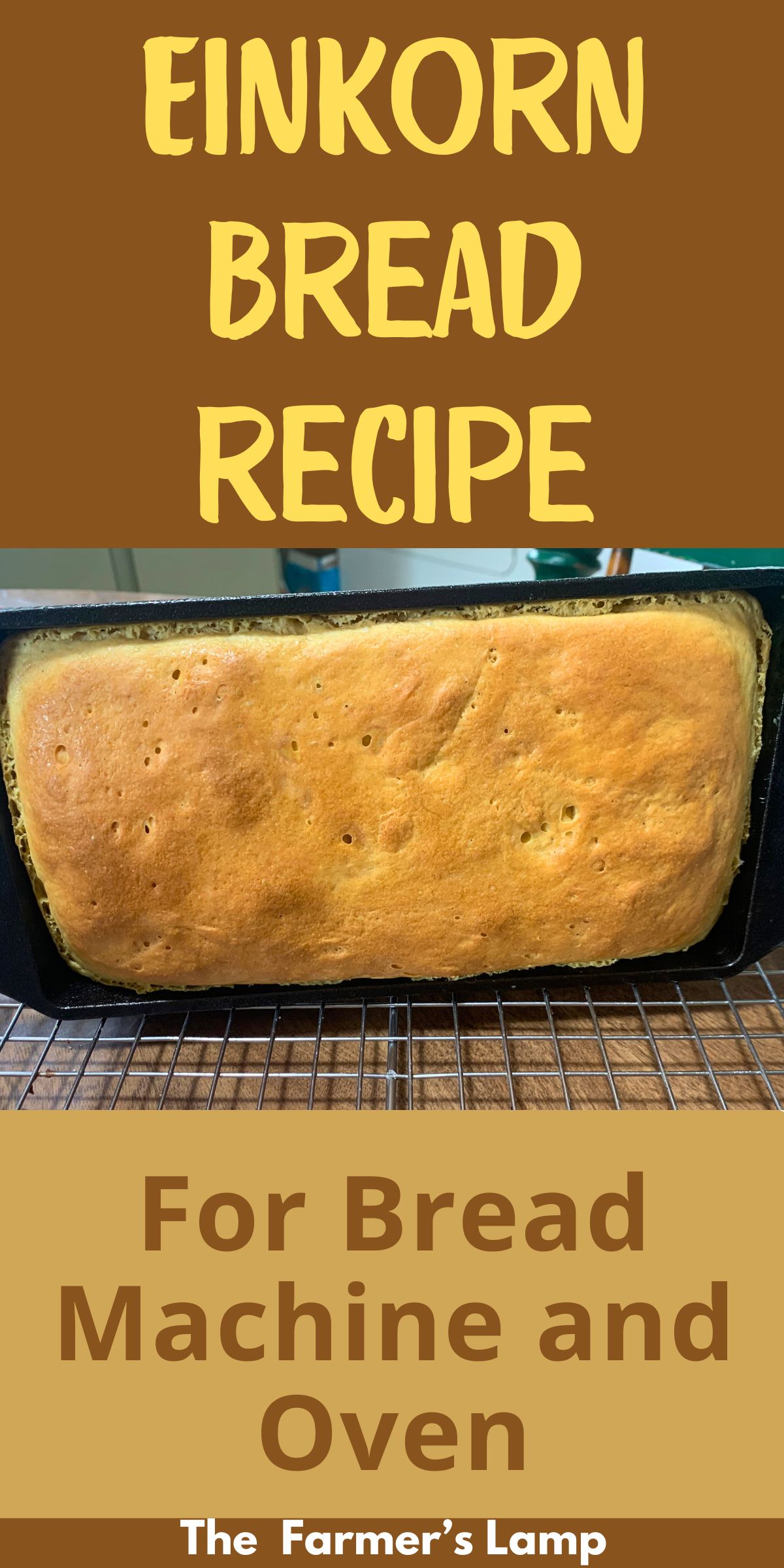


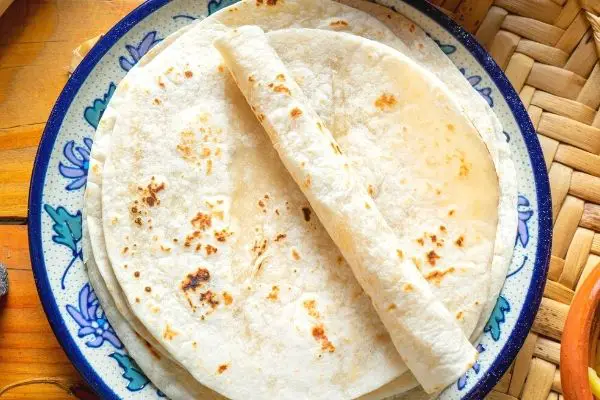
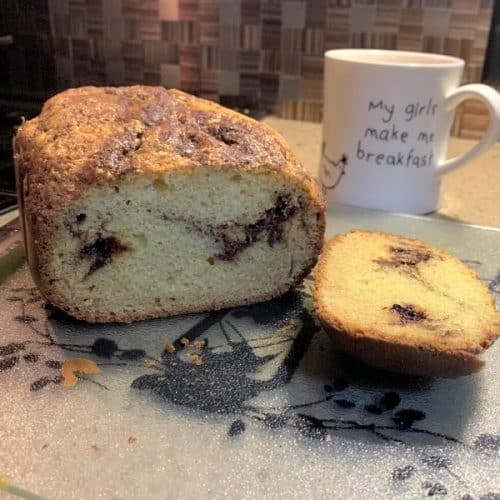

Thank you so much for this recipe! I recently read of the benefits of einkorn flour so have been checking out recipes and finally followed through with this one. I used my mixer with the dough hook for 10 minutes and then followed the directions for baking in the oven. Absolutely perfect! I think this is one that my husband and I can have on hand to use as our “regular” bread. I am looking forward to checking out more of your recipes since this one turned out so well. Thank you for taking the time to post these for the benefit of so many newbies…and I’m sure even seasoned einkorn bakers. 🙂
Hi Nancy, I’m thrilled you found a recipe you love. If you run into anything in any of my recipes, feel free to reach out. I’ll do all I can to help! Thank you so much for sharing your experience with me.
So, my bread maker makes a 2 pound loaf, will this recipe make a 1 pound? Then, shall I just double everything for a 2 pound loaf?
Hi Kerri, If your bread maker makes a two pound loaf it should have a setting for a one pound loaf, however, you can double the recipe to make a 2 pound loaf. I’ve never tried because it’s just the two of us, so let me know how it works for you.
I used whole wheat Einkhorn flour and it didn’t rise much at all…what should I do differently to use whole wheat einkhorn flour rather than all-purpose?
Hi Sheryl, In this post you’ll find helpful links to other articles that can help you for your convenience, I’ll answer the question here. When substituting whole wheat Einkorn Flour for all-purpose Einkorn flour, use ¾ cup Einkorn whole wheat flour (96 grams if you’re weighing) for every 1 cup of all-purpose flour. For example, your recipe calls for 2 cups of all-purpose flour, to use Einkorn Whole wheat flour as a substitute, you would use 1 ½ cups.
Also, increase the amount of liquid by 5% because the bran and fiber contained in whole wheat absorb more than all-purpose flour.
If you want to learn more, check out the links in this article. I hope this helps, let me know if I you have any other questions or need assitance. Happy Baking!
Hi. Why not use an egg in the recipe? Just curious.
Most bread recipes do not call for eggs; the exception is enriched breads, such as crescent rolls, muffins, etc. Eggs are a binding agent, as you know, and they would change the texture of bread. I hope this answers your question. Thanks for being a part of TFL!
This just collapsed in my oven
Hi Dawn, I know how frustrating it is when that happens. In step number 7 of the recipe I share that overprooving will cause Einkorn dough to collapse when baking. Prooving times can vary from kitchen to kitchen so we give general proof times in a recipe. You can also find some tips on what may have happened in our article about baking with Einkorn flour. Let me know if this helps or if I can help further.
Maybe I’m missing something . . . but don’t you need some sort of sugar for the yeast to feed off of? I realized that halfway through my mixing cycle and added some honey. I’ll let you know how it turns out.
Camilla, While most bread recipes call for sugar to feed the yeast, it isn’t necessary. We try to not use sugar when we don’t have to. I never put sugar or honey in my bread unless I’m making cinnamon bread, banana bread, or some such. It won’t harm the bread if you want to add it. Thanks for reaching out and let me know how it goes.
Today is my first attempt ever at making my own Einkorn sandwich bread. It’s working through its pre-programmed menu for Gluten Free bread. No idea how this bread will turn out…hoping it will be edible for me as I am allergic to guar gum and cannot find G-F bread in stores that don’t have guar gum as an ingredient.
My breadmaker does not allow me to alter any of it’s programming to be able to follow your sandwich bread recipe as instructed for kneading or rising, etc.
Have you any helpful suggestions other than buying a breadmaker that does allow minute programming?
Also, I had to use salted butter, but didn’t further add the real salt. (My taste doesn’t like salty foods.) Have you another suggestion for when I have to use salted butter?
By the way, what bread maker do you own that allows you to alter its programming, just in case I need to buy one, too?
Hi Linda, I don’t alter the programming on my machine because, like yours, it doesn’t have programmable options. As I said in the recipe, I have to set my machine on the whole wheat bread setting and then set a timer to remind me to stop it after the mixing cycle. I do this because this setting has a 10-minute kneading(mixing) cycle. So use whatever cycle on your bread machine has a 10 minute mixing/kneading cycle.
You could always use the oven baking directions and bake it in the oven, or you can mix and knead it by hand then put it in the bread machine to rise and bake. As for the salt, you did what I would do if I used salted butter, just leave out any other salt the recipe calls for.
I hope addressed all your concerns, if not, please feel free to reach out again. Let me know how your bread turned out.
Here’s the link to a bread machine that is programmable just in case that’s what you still want to do.